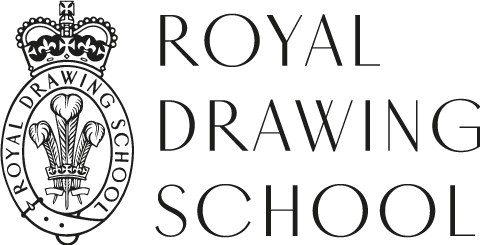Honor Bathurst
Drawing Year 2023
Edinburgh University, BA French and History of Art

Tell us about your practice and the part that drawing plays...
I have an interdisciplinary artistic practice for which drawing is essential. It’s the first point of contact for me, the way I translate a sensation or a brain scramble, as well as being an act of presence and meditation.
What were you doing before The Drawing Year and what drew you to apply?
Before The Drawing Year, I was living in France and working freelance in costume design, making, and dressing for musicians, theatre and TV productions. I kept a lot of sketchbooks and felt that developing and pushing my drawing would feed into and strengthen my creative practice as a whole, in whatever medium I chose to work.

Which courses have most impacted your practice?
The outdoor classes have given me the tools to take drawing anywhere, learn how to make the most of limited materials, and respond quickly, strengthening my ability to process surroundings and connect to the sensations a place might provoke. Graphic Narratives was a class that extended my perception of what drawing could be, offering an important space to explore personal and political subjects, and encouraging collaborative work and peer support.
Tell us about the sense of community on the course...
Drawing with others is a deeply bonding activity, to be able to do that for a year creates strong friendships and rich creative connections. The weekly core days and shared studio space allow you to connect as a year group, make alongside each other, and share feedback and resources.

Which tutors have you most enjoyed working with and why?
Mark Cazalet’s teaching was a highlight of the year for me, his classes were always engaging, researched, attentive, and playful. Maggie Jennings’ classes in particular pushed my material experimentation and technical rigour in printmaking, and Daniel Chatto’s enthusiasm for the potential of hand-crafted materials encouraged me to find and hone the mediums that worked best for me.

What are the most important things that you've learned during the year?
I learned some patience, and to trust in the process of repeatedly responding to observation and materials. There were moments of confusion, frustration, and exhaustion, but this was balanced by constant discovery, and I left the year with a lot more confidence in my creative ability.
What has surprised you about The Drawing Year?
I was surprised by how much I learned from my peers on the course. I was continuously moved and inspired by their work, and the variety of everyone’s approaches to drawing encouraged me to work in many different ways.

How has your approach to drawing changed since the start of the course?
As well as anchoring drawing as a daily practice, I now make work that exists beyond the sketchbook and feel equipped with the tools and desire to make more sustained and considered images. Having been a primarily solo activity for me, I now understand the possibility of drawing as a collective and social practice, which has also made me more open to sharing my work with others.
What opportunities have arisen due to The Drawing Year?
Thanks to an exchange program between the Drawing School and the Rhode Island School of Design, I was able to take part in the ‘Drawing Marathon’ 5 week residency at RISD, in the US. It was an amazing opportunity to have an intensive learning experience in a different art school context and push my drawing practice even further on the back of The Drawing Year.

What are you going on to now you have completed the course?
I intend to spend the next year using drawing to inform and develop my other creative practices, primarily painting and textile work. I’m looking forward to finding a studio.
What does it mean to you that the course has no fees and a free studio space?
The course’s full scholarship and free studio space are a precious rarity, especially in somewhere like London. I think that this, and the lack of a grading system within the course allowed me to relax a little and make the most of the intensive learning opportunity.

What is it like to study and live in London?
There is so much to see, do, and be inspired by in London. It is also busy and tiring to navigate alongside the course, but the long breaks during the year allow some time to absorb the city or work and process the drawing time.
What advice would you give to someone considering applying for the course?
If you aren’t already, start taking walks and filling sketchbooks. And if you take the course, trust in the process!
